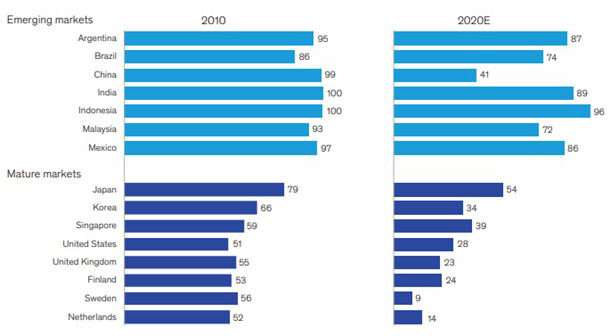PayPal riding post-pandemic payment trends
Wednesday 12 May 2021
Portfolio insights
2020 was undeniably a whirlwind year for PayPal. The 23-year-old payment technology provider logged record user and transaction volume growth. What’s more it released more than 60,000 configuration and software updates. PayPal’s stock market outperformance reflects its business growth, having risen over 185% from its March 2020 lows.
We had anticipated platform growth to slow as some of PayPal’s core markets began reopening. However, its first quarter results and fiscal year outlook demonstrate continued momentum across its business portfolio. PayPal ended the first quarter of 2021 with 392 million active accounts, up 14.5 million from the prior quarter. Total payment volumes (TPV) reached $285 billion, up 50% year-on-year.
We believe PayPal is primed to benefit from these multi-year industry trends:
- Cash to cashless acceleration driven by digital commerce
- Merchants differentiating through payment offerings
- Financial inclusion and empowerment
- Blockchain-based payments
Cash to cashless acceleration
While the concept of a cashless society has been around since the mid-20th century, the transition is slow. The following chart from McKinsey highlights the dominance of cash transactions in 2010 despite the existence of digital payment enablers such as PayPal and Mastercard, reflecting the difficulty in changing user behaviour.

Pandemic response
The pandemic exposed the benefits of digital payments and McKinsey’s estimate of a reduction in the proportion of cash transactions in 2020 did actually occur. Digital Commerce 360 found consumers spent over $2.67 trillion on the top 100 online marketplaces in 2020. It also noted markets with historically lower ecommerce penetration grew substantially. For example, US ecommerce grew 44%, the highest annual growth in at least two decades.
This is reflected in PayPal’s 1Q21 US-based TPV, which grew 60% year-on-year to over $171 billion. Additionally, PayPal’s 1Q Cross-Broder Trade TPV grew 51% year-on-year to over $48 billion, reflecting PayPal’s global scale and reach.
Offline commerce presents a significant opportunity for digital penetration. As users increasingly favour omnichannel experiences and cashless payments, merchants will increasingly integrate online and offline businesses and adopt cashless payment options to cater to customer needs. PayPal valued its offline retail addressable market at $8 trillion compared to its online opportunity at $2 trillion. As noted by PayPal CEO Dan Schulman during the earnings call:
“we brought on in Q1 two new customers every second” and “demand for our PayPal and Venmo QR codes and in-store payments remains strong, with an additional merchant signing up every 28 seconds.”
Undeniably, the public health crisis accelerated the transition to cashless transactions, and we believe it has led to a sustained shift in consumer behaviour. Now a 10x benefit in cash payments compared with cashless options is needed to induce a shift back to cash.
Merchants differentiating
As consumer and businesses shift online, digital interfaces became primary engagement channels and thus key differentiators. Payment interfaces not only facilitate transactions but also directly influence customer experience, conversion and loyalty. Nielsen’s consumer studies statistics demonstrate PayPal’s value proposition for merchants. PayPal brings 17% more repeat buyers, completes 34% more checkouts, increases Net Promoter Score of merchants by 14% while PayPal users buy 11% more often when PayPal is accepted.
To come out on top in the increasingly competitive digital commerce space, transaction speed has become more important than ever. PayPal enables businesses to quickly access customer payments, working capital, data and insights. PayPal’s competitive advantage lies in its highly scalable two-sided network, which allows the company to provide timely and quality tools and services at all stages of commerce.
Financial inclusion and empowerment
In Q321, PayPal will launch the next generation of its PayPal digital wallet featuring a comprehensive set of tools covering payments, commerce and finance. Two services in particular will contribute to greater financial empowerment.
In-app investment capabilities
Pandemic limitations, stimulus checks and easier access to financial products and information brought a flood of new retail investors to the stock market. JMP Securities estimates the brokerage industry added roughly 10 million new clients in 2020, based on app download data from SimilarWeb. The PayPal digital wallet enables users to seamlessly invest in stocks and cryptocurrencies natively within the app.
This plays into PayPal’s virtuous cycle of adding more services to boost engagement, leading to lower churn and higher user growth. PayPal estimates the lifetime value of a person using crypto services increases by $25, representing a potential $9 billion uplift to revenues based on PayPal’s 361 million active customer accounts.
Pay in 4, PayPal’s buy-now-pay-later (BNPL) product
BNPL products have become increasingly popular. We believe their popularity is connected to the larger movement towards financial empowerment as they enable anyone to access credit, avoiding the usual limitations of credit cards which depend on credit histories, low transparency and high fees.
Since its launch in the second half of last year, PayPal’s Pay in 4 has reached over $2 billion in payment volumes across 5 million unique consumers transacting with more than 500,000 merchants since its launch in the US, UK and France.
Blockchain-based payments
While the payment industry has evolved for the better over the past decade, many pain points remain. Blockchain technology has emerged as potentially the next payment infrastructure to facilitate fast, secure, low-cost payment flows without the need for intermediaries.
Currently, over 75 central banks globally are exploring central bank digital currencies (CBDCs), and PayPal is aiming to support their potential implementation. During his first quarter earnings call Dan Shulman said “our leadership in all forms of digital currency has been widely embraced, enabling numerous positive conversations with central banks, regulators, and government officials around the world.”
Mr Shulman noted during a recent payments conference, PayPal’s view of cryptocurrencies is “less about the hype of the price point of it and much more into the utility of what a blockchain-based payment can look like”. Facilitating the purchase of goods and services using cryptocurrencies and future CBDCs will assist PayPal to drastically expand the utility of blockchain-based payment flows and ensure the company remains a key component of the future financial system.
We are excited see PayPal deliver innovative services to its users and merchants and incremental return to its shareholders as the company continues to execute its mission to “democratise financial services to ensure that everyone, regardless of background or economic standing, has access to affordable, convenient and secure products and services to take control of their financial lives”.




